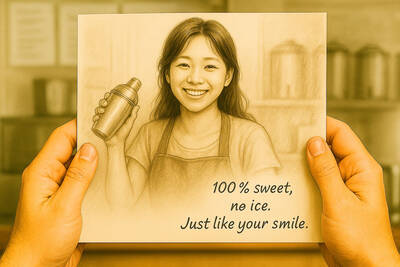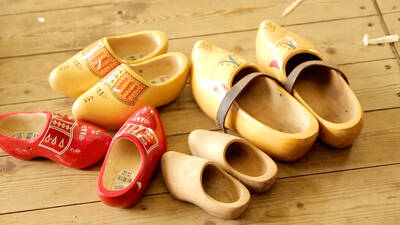From May, a 46-year-old woman started getting hives around 4 or 5 in the afternoon and 3 to 5 in the small hours of the morning. The nocturnal itchiness of the skin, in particular, made it difficult for her to sleep. She sought medical help, taking one or two antihistamine tablets every week, but the symptoms did not improve. A traditional Chinese medicine doctor prescribed medicine based upon the patient’s “damp-heat” condition and chronomedical concepts and, after a week of treatment, the patient’s symptoms manifested less frequently and were far less itchy during the night, no longer affecting her sleep.
According to Chou Shu-yu, a Chinese medical doctor in the Hsinchu branch of the China Medical University, hives are a common skin condition twice as likely to affect women than men. Their symptoms include itchiness and rashes that can continue for a few hours to a day and, after the symptoms have abated, rarely leave any traces on the skin. They are often brought on by infections, dust mites or allergies to medicines or food, and the food allergens are often milk, eggs, nuts, peanuts, wheat products, seafood, mangoes, kiwi fruit and strawberries. Some people are affected by changes in temperature, exposure to the sun, stress, and mechanical irritants, but in many clinical cases the cause of the onset is unknown.
The treatment of hives and skin rashes in traditional Chinese medicine depends on the unique situation of each patient, requiring different medicinal ingredients. When improvements in the patient’s physical condition occur, the symptoms will naturally abate.

Photo: Liao Hsueh-ju, Liberty Times
照片:自由時報記者廖雪茹攝
According to Chou, the aforementioned female patient had identified the specific times of the rash’s onset. Factoring in the damp-heat nature of the woman’s constitution, and in line with principles of traditional Chinese chronomedicine — which state that qi flows to the bladder meridian between 3 and 5 in the afternoon and to the lung meridian between 3 and 5 at night, the primary treatment was to be xiaofengsan (“wind dispersing”) powder supplemented with medicinal ingredients including lily, mulberry bark and a bupleuri and ramuli cinnamomi decoction. After this was administered for a week, the condition improved, according to the patient.
(Translated by Paul Cooper, Taipei Times)
一名四十六歲女性今年五月開始,經常在午後四點至五點、凌晨三點至五點出現蕁麻疹,尤其半夜皮膚癢到無法入眠,求診後,每週服用一、兩顆抗組織胺仍未改善。中醫師根據患者身體濕熱的情況以及中醫時間醫學的觀念,對症下藥,經一週治療,患者的發作頻率終於降低,夜間癢的程度也減輕許多,不再影響睡眠。
中國醫藥大學新竹附設醫院中醫科醫師周書玉表示,蕁麻疹是一種常見的皮膚疾病,女性發生率又為男性兩倍,症狀為皮膚癢、起紅色斑塊,大約持續數小時到一天時間,症狀緩解後通常不留痕跡。常見誘發原因如感染、塵?、藥物或食物過敏;常見食物過敏原包括牛奶、蛋、堅果、花生、小麥製品、海鮮、芒果、奇異果、草莓等;有的人則是受到溫度變化、日曬、壓力、機械性刺激而誘發;但臨床上依然有許多人是不明原因的發作。
因此,中醫治療蕁麻疹會根據每個患者不同的身體狀況,以不同的藥物治療;當身體狀況改善,症狀自然能解除。
周書玉說,前述這名女性患者,特別提到蕁麻疹有好發時間;因此,她根據患者身體濕熱的情況,以及中醫時間醫學的觀念,午後三點至五點氣血流到膀胱經,半夜三點至五點氣血流注到肺經,以消風散為主方,加引經藥,如百合、桑白皮、柴胡桂枝湯等,經一週治療,患者表示,症狀已有所緩解。
(自由時報)

Denmark’s state-run postal service, PostNord, announced that it would cease letter deliveries at the end of 2025 due to the impact of digitalization. As 95% of its residents now use the Digital Post service, Denmark has seen a 90% decline in letter volumes since 2000, from 1.4 billion to 110 million last year. On top of that, the Postal Act of 2024 removes the government’s obligation to provide universal mail service and puts an end to postal exemptions from value-added tax, raising the cost of a single letter to 29 Danish krone (US$4.20). As a result, PostNord is switching

Bilingual Story is a fictionalized account. 雙語故事部分內容純屬虛構。 “One DA-BEI... WU LONG... NAI?” Yujing smiled as the foreigner struggled to order. He looked like an embarrassed puppy. She repeated the order in Chinese, then English: “Oolong milk tea, large size. Half sweet, no ice?” she said gently. He beamed — the kind of full-face, sunshine smile that Latinos are famous for. “Yes! That! You are... lo maximo… the best!” After he left, Lily nudged her. “Nice save. You’re getting the hang of it.” Yujing had taken this summer job at the bubble tea shop to build confidence and get work

When you think of the Netherlands, images of tulips, windmills, and iconic wooden shoes — known as “Dutch clogs” — may come to mind. These traditional shoes are rich in cultural significance. For centuries, Dutch clogs have been admired for their sturdy design and impressive craftsmanship, making them a fascinating symbol of Dutch heritage. Dutch clogs date back to the Middle Ages. During that time, farmers and laborers needed durable shoes to cope with the region’s damp and unpredictable climate and topography. Crafted from solid wood, such as willow or poplar, clogs offered outstanding protection. Their firm structure kept

Although sending you an SMS (Short Message Service) verification code provides some security, many apps now use code-generating apps and two-factor authentication instead. But more recently, passkeys now use a biometric approach to logging in. Biometrics can offer an even more secure alternative. Following this trend, Google is reportedly planning to replace SMS verification codes with “QR code” scanning. SMS codes are currently used to verify user identity and prevent fraudsters from creating fake Gmail accounts to distribute spam. However, these codes present several challenges. They can be phished through suspicious links, and users may not always have access